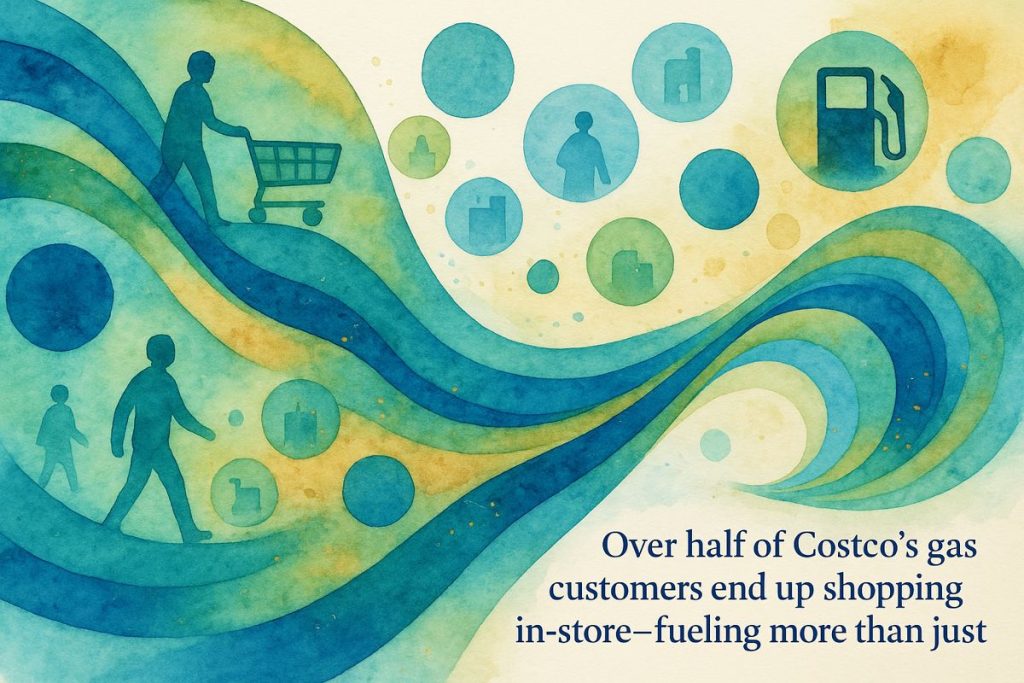Cheap gas draws huge crowds, who then often shop inside the store, boosting sales and loyalty. In 2025, big retailers like Costco, Walmart, and BJ’s are turning gas stations into powerful magnets for customers. Costco leads this trend, making gas a major part of its business and tying it to memberships and in-store deals. Other chains like Walmart and Dollar General are quickly building more fuel stations to grab their share of shoppers. Digital tools and special offers wrap it all together, making every fill-up a chance to shop, save, and stay loyal.
How are major retailers like Costco, Walmart, and BJ’s changing gas stations in 2025?
Major retailers such as Costco, Walmart, and BJ’s are transforming gas stations in 2025 by integrating fuel sales with retail strategies. They use cheap gas to attract customers, boost loyalty, drive in-store shopping, expand fuel locations, and leverage digital tools for personalized offers and omnichannel engagement.
The Hum of Change: Gas Pumps as Retail Trojan Horses
Step onto a Costco lot at 6 a.m.—the air buzzes faintly with anticipation and gasoline’s sharp tang. If you’re alert (and not merely caffeinated), you’ll notice the choreography: cars snake around the pumps like a patient python, while inside, the warehouse whirs with forklifts and a low, collective murmur of bargain-hunters. Gas is no longer just a commodity; it’s a gravitational force pulling wallets and shopping carts in its wake.
Major retailers—Costco, Walmart, BJ’s Wholesale Club, Dollar General—are betting big that fuel isn’t just for engines. It’s for foot traffic, loyalty, and what the analysts at Seeking Alpha might call “omnichannel stickiness.” Is it working? Well, let’s just say if you fill up at a Costco, you’re more likely than not to leave with a 60-pack of toilet paper and a lingering whiff of hotdog.
This isn’t hyperbole. Costco’s fuel operation now sprawls across 719 locations worldwide, tripling since 2004 and feeding a voracious cycle: cheap gas draws crowds, crowds buy memberships, memberships fund more cheap gas—and so on, ad infinitum. Have you ever wondered—can a gas station really be a retail palimpsest, layering impulse over necessity? I used to scoff. Now, I’ve seen the receipts.
Costco’s Fuel Gambit: Numbers, Nostalgia, and a Dash of Hubris
Costco, ever the colossus, wields numbers like a chef sharpens knives. As of 2025, their fuel business comprises roughly 12% of total revenue, with some pumps slashing as much as 30 cents per gallon off local competitors (Costco Wholesale Corporation Reports April Sales Results (2025)). It’s not charity—it’s scale. Think hyperspectral efficiency: bulk contracts, relentless negotiation, and a membership model that keeps the riffraff (mostly) at bay.
I had to stop and ask myself—why do I find the aroma of Costco fuel oddly comforting? Maybe it’s nostalgia for road trips past or the Pavlovian association with free samples. But here’s another vignette: last October, I watched an elderly couple fill their tank, then waltz into the warehouse and emerge triumphant with a rotisserie chicken and a 5-pound bag of pistachios. The symbolism is almost too on-the-nose.
Expansion, too, is relentless. With 27 new warehouses slated for fiscal 2025 and gas stations chaining themselves to nearly every grand opening, the company’s omnipresence is almost—dare I say?—Orwellian. Hours now stretch from pre-dawn (6 a.m.) to late evening (10 p.m.), and ongoing renovations at 50-60 locations ensure the machinery never quite stands still (CBS News; Money Talks News). I once got lost in a tangle of orange cones and rumbling compressors out front; the construction dust tasted like ambition and burnt rubber.
Walmart, BJ’s, and Dollar General: The Widening Ripple
Costco isn’t alone in this high-octane ballet. Walmart, that brawny juggernaut of Bentonville, is cranking its fuel engine too: 45 new stations this year alone, aiming for north of 450 locations. The logic? In a world where fuel prices bob up and down like a seismograph, capturing the price-sensitive crowd has never been more lucrative—or more competitive.
BJ’s Wholesale Club plays a narrower, but no less crafty, game. Four new stations in just the first quarter of 2024 bring its total to 190, each one anchoring a little eddy of retail gravity. BJ’s pumps aren’t just about octane; they’re about orchestrating a dance between gas, groceries, and the surprisingly passionate warehouse club community.
And Dollar General? Here’s a twist: over 40 gas-equipped sites, many in places that even map algorithms stutter to locate. Since first dabbling in fuel back in 2013, Dollar General’s approach feels less like a tidal wave and more like a quietly persistent spring—testing, tweaking, nudging closer to the elusive holy grail of “total convenience” (Money Talks News). I once fueled up at a Dollar General in rural Missouri, the pump’s screen flickering like a firefly; for a moment, I felt a pang of gratitude—and, oddly, community.
Beyond the Pump: Data, Loyalty, and the Scent of Change
Digital transformation now clings to these gas stations like the perfume of ethanol. Retailers are busy weaving apps, digital coupons, and personalized offers into the fueling ritual
